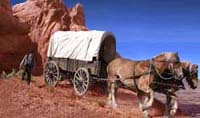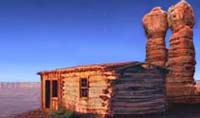Covered wagons and the horses, mules, and oxen that powered them were crucial to the colonization of the West. The covered wagon’s high ground clearance made it suitable for the rugged terrain. When the load was heavy or the grade was too steep for one team, animals were shared/doubled up. At The Dugway (section of Cottonwood Hill) and San Juan Hill, the grades were so steep, seven span of horses required to pull one wagon. Descending the steep grades was also a major challenge. In the video clips below, Montel Seeley demonstrates the breaking techniques employed by the pioneers. Montel Seeley, a descendent of the Mackelprangs (Hole-in-the-Rock pioneers), had a great love and respect for the pioneers . Montel tragically died in an accident during a pioneer reenactment/trek, August 2008. He will be sorely missed. |



